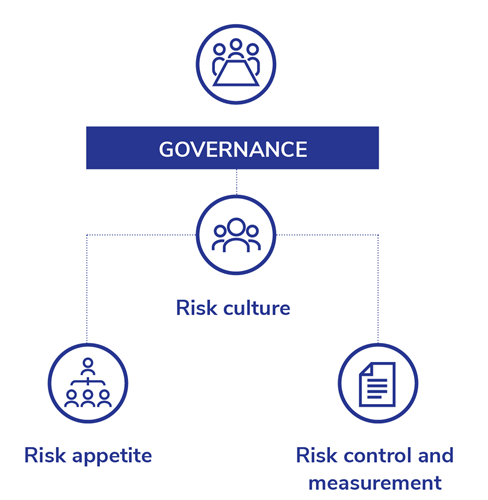Risk management is a critical part of how Housing Australia achieves its business goals. Housing Australia has developed a risk management framework that defines its principles, culture, policies and processes for managing risk. The organisation systematically identifies and manages risk to increase the likelihood and consequence of positive events while mitigating negative events.
Housing Australia’s Risk Management Governance Framework

Risk governance
The Board is responsible for defining Housing Australia’s risk appetite, approving the Corporate Plan, and establishing an appropriate risk management framework. It relies on Housing Australia’s executive team to manage the implementation and embedding of risk appetite in Housing Australia’s activities and to monitor performance and report as appropriate to the ARC and/or Board.
The Board engages an independent auditor to review Housing Australia’s risk management approach, including risk assessment and control effectiveness. Audit reports are submitted to the Board through the ARC and the ERCC.
Auditors are provided with access to employee and organisational data to support their reviews.
Risk culture
Housing Australia’s risk culture and principles guide everyday behaviour in the organisation.
Housing Australia strives to:
- Maintain the highest professional and ethical standards focusing on embedding appropriate behaviours
- Align employee remuneration and other benefits to encourage behaviour consistent with good governance and Housing Australia's risk appetite
- Provide an environment where employees are empowered to the full extent of their abilities and that fosters innovation and learning within business practices
- Monitor, stress test and re-evaluate risk ensuring management information systems and risk reporting accurately reflect the underlying risk
- Maintain compliance standards reflecting zero tolerance of regulatory and compliance breaches
Risk appetite
Risk appetite is a fundamental part of both risk and capital management.
The Board’s Risk Appetite Statement sets the boundaries for the risks that Housing Australia may accept to achieve its objectives within risk policies, risk tolerances and operational limits set by the Housing Australia Act, Investment Mandate, PGPA Act and the Board.
Housing Australia's risk appetite represents the types and degree of risk that it is willing to accept for its stakeholders in its strategic and business actions.
Housing Australia’s risk appetite is:
- Dynamic. Regular Board reviews ensure alignment with the Corporate Plan and Government policies, such as the Investment Mandate.
- Defined. Clear tolerances and governance procedures guide decision-making and compliance.
- Encompassing. A structured framework shapes the internal risk culture, using both quantitative and qualitative metrics to provide comprehensive oversight.
- Judgement based. We carefully weigh diverse perspectives, ensuring risk decisions reflect strategic judgment.
Risk control and measurement
Housing Australia management undertakes regular risk reviews to ensure that our strategic and operational activities align with the Board’s appetite for risk. Housing Australia follows established risk review procedures to ensure that we have a consistent view of the risks we face. Information on significant risks, collected through this process, is reviewed by senior management prior to being reported to the Board and Audit and Risk Committee (through the regular provision of the risk dashboard and RCM).
Risks are classified depending on their nature. Housing Australia’s key risks fall into the following risk categories (as described further in the table below).
| Risk | Definition |
|---|---|
| Compliance risk (including anti-money laundering risk, contractual risk, internal policy risk, legislative/regulatory risk, probity/conflict of interest risk) | The risk of legal or regulatory sanction, financial, reputation loss arising from failure to abide by obligations required of Housing Australia. |
| Financial risk (including funding risk, liquidity risk) | The risk of financial loss or potential for financial loss due to volatility in market conditions and economic factors. |
| Market risk (interest rate risk, treasury counter-party risk, foreign exchange risk) | The risk of an adverse impact on earnings resulting from changes to potential changes in market or asset class. |
| Operational risk (business disruption/failure risk, conduct risk, cyber-security risk, data risk, execution/project risk, external fraud risk, internal fraud risk, people risk, shared risk, technological risk) | The risk of loss resulting from inadequate or failed internal processes, people, and systems or from external events. |
| Strategic risk (current and emerging risk, product development/sustainability risk, reputation risk) | The risk of threats or uncertainty that can affect Housing Australia's ability to meet its purpose and objectives. |
| Credit risk | The risk of financial loss where a customer fails to meet their financial obligations to Housing Australia. |